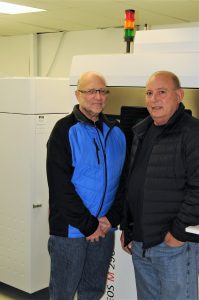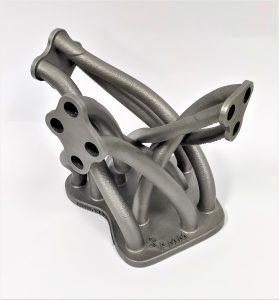
ADDITIVE METAL MANUFACTURING wants to make you more competitive
Canadian Plastics
Canadian Plastics MoldmakingThis Concord, Ont.-based engineering and design consulting firm is rewriting the book on mold heat removal by 3D printing inserts with complex cooling channels that can dramatically cut cycle times and consolidate manufacturing processes. And it might just be the kick in the pants that Canada’s plastics processors need to start kicking butt globally.

AMM’s founding partners Norman Holesh (left) and David Slimowitz. Photo Credit: Additive Metal Manufacturing
An old adage says that generals always fight the last war. Meaning that when a new war starts, they repeat what was effective last time, usually with disastrous results. And it applies in manufacturing wars, too — if the owners and decision-makers don’t adapt and change, their companies will keep losing the battles, all the way to bankruptcy.
It’s a grim fate that Additive Metal Manufacturing (AMM) wants to help Canada’s moldmakers avoid, by offering them a new technology that can make them — and their plastics manufacturing customers — more competitive globally. The Concord, Ont.-based engineering and design consulting firm uses metal additive manufacturing to 3D-print mold inserts to a customer’s individual specification, allowing for the insertion of conformal cooling channels in geometric designs that were previously not attainable, to better manage thermal issues and dramatically reduce time to market.
EUREKA MOMENT
AMM was founded in 2014 by a group of manufacturing veterans with more than 100 years of industry experience between them, and who had all suffered from long lead times and manufacturing processes invented decades earlier. The inspiration for the company came when Norman Holesh, one of AMM’s principals, attended an information night on 3D printing. “The focus of the session was on plastics, but I was struck by the potential for 3D printing with metals,” said Holesh, who serves as the company’s CEO. “Canada’s moldmakers really need something new to help them compete and bring tooling work back from low-cost countries, especially those shops that are scraping by on old-school methods. The last innovation that disrupted and benefitted the moldmaking sector was CAD technology, and that was a long time ago. Metal additive manufacturing will have the same impact.”
The founders — together with a staff of younger, tech-savvy engineering school graduates — currently operate two EOS laser sintering machines for 3D printing mold inserts. “The machines are very expensive compared to high-quality 3D plastics printers that retail for as little as a few thousand dollars,” Holesh said. These machines melt and sinter powdered metals, including stainless tool steel and aluminum, onto a grow plate in 40 micron layers — thinner than a human hair — building each part layer by layer to produce cost-efficient, high-quality metal tool inserts, prototypes, and final products. As built, the parts are between 30 and 35 hardness on the Rockwell scale, and the hardness can be increased to a range of 50 to 55 Rockwell. If needed, the parts can be welded, polished to a mirror finish, drilled, and tapped.
BIG PROBLEM SOLVED
The additive metal manufacturing pro- cess uses conformal cooling to manage the mother of all mold tooling challenges: heat removal. “Traditional cooling channels for molds are drilled in secondary machining operations, and they follow straight lines,” Holesh said. “Conformal cooling channels follow the geometry of the part that’s being produced, reaching the hot spots that couldn’t be reached previously. This manages the thermal differential within the mold, dissipating the heat faster and resulting in an increase in capacity and longer tool life. Another benefit is reduction of scrap.”
But there’s always been a downside to conformal cooling: Many in the industry think the technology is too difficult and too expensive, which — depending on your circumstances — might be true. And they often don’t recognize the impact of conformal cooling across the entire cost spectrum. Which is where the benefit of 3D printing conformal cooling channels comes in. “Making tooling inserts the traditional way is subtractive manufacturing: you start with a block of steel and the more you chip away at it, the more it costs you,” Holesh said. “But with additive manufacturing, you only pay for what you get. Designers have the freedom to place the channels where they’re needed, and they can be as complex or as simple as the shape of the tool dictates.”

Cooling channels 3D printed by AMM. Photo Credit: Additive Metal Manufacturing
This is good news for moldmakers and end-users alike. “Additive manufacturing keeps the costs down by saving weight and tooling time; it has the design freedom to print only what’s needed, which are the cooling channels,” Holesh said. “And they can be as highly complex as the designer wants to make them because we can print water channels in any pattern.” In other words, the moldmaker gets inserts that offer all of the benefits of conformal cooling at a fraction of the time and cost. “Conformal cooling rapidly removes the heat from the tool, which translates into a reduction of cycle time of between 25 and 50 per cent, and consolidation of manufacturing processes,” Holesh continued.
Another benefit of the technology, Holesh said, is speed to market. “Inserts can
be 3D printed in a few days, which shortens the lead times by weeks or even months over traditional insert making,” he said. “And because we can often print a final part for both fit and function, the production of a soft tool is eliminated.”
CULTURE SHOCK
The biggest hurdle that AMM and its technology faces isn’t technical, Holesh said, but cultural. “Some toolmakers and injection molding experts resist adopting a new technology because they know the old ones so well and think they’re doing fine with them,” he said. “What they may not realize is, they don’t have a choice. Canada’s manufacturing supply chain is shifting towards more advanced technologies and global markets, and metal additive manufacturing is going to happen whether people like it or not.”
To help normalize metal additive manufacturing, AMM recently joined forces with Mohawk College to give students in the college’s Mechanical Engineering Technology and Non- Destructive Testing programs the opportunity to work directly with AMM engineers on research and development projects aimed at helping manufacturers adopt the technology. The students will have the opportunity to work at both the Additive Manufacturing Centre at Mohawk and AMM’s production facility, where they’ll work directly with full-time engineers and customers to gain first-hand experience solving real-world commercial and engineering issues. “We’ve found that most graduates from university and college don’t have the hands-on experience with the technology or the commercial experience of working with customers,” Holesh said. “This experience will teach them how to work with customers.”
AMM has also enlisted well-known sales representative Larry Bonehill, the owner of Uxbridge, Ont.-based Shadow Automation Inc., to represent it in the province. “Larry is a trusted name in the plastics industry, and he’ll help convince some of the skeptics,” Holesh said.
So if the only thing moldmakers have to fear about 3D printing with metal is fear itself, they can relax. AMM isn’t a tool shop, Holesh said, and won’t compete with existing machine shops. Instead, they see the business as a service bureau for additive manufacturing. “Moldmakers should understand that we’re not building the tool, we’re just supplying the inserts,” Holesh said. “We’re trying to help them build molds faster, not take business away from them. It’s a collaboration that benefits them as well as the processors that use the finished molds.”
And it might just give these processors fighting chances to win today’s manufacturing war.
